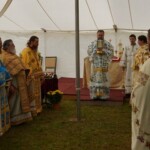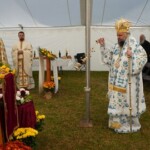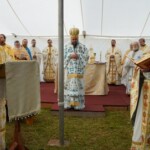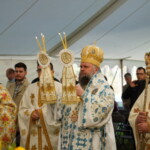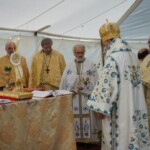On Saturday, October 26, 2019, St. Dimitrios the New Romanian Monastery of Middletown, New York celebrated its feast day. The feast began on Friday evening with the celebration of the Great Vespers with Lithia and continued on Saturday when His Eminence Nicolae, Metropolitan of the Romanian Orthodox Metropolia of the Americas, served Matins and Divine Liturgy surrounded by 11 priests and one deacon. The answers were given by the cantors of the Metropolia parishes of the New York area. Many faithful of these parishes also participated into the celebration. Before the beginning of the Divine Liturgy, HE Nicolae ordained as a reader the young Alexandru Popovici, a graduate of the master’s courses from St. Vladimir Theological Orthodox Seminary in New York.
The sermon was offered by His Eminence Nicolae, who talked about St. Great Martyr Dimitrios, the Myrrgusher, commemorated on that day, and about the protector of the monastery, St. Dimitrios the New: Both saints are examples of the confession of faith in Christ, one with the price of his life, the other with a sanctified life through the humble service of Christ. Over the years, their holy relics are the proof of the work of the Holy Spirit in their lives. This work continues in the Church and in the life of every Christian, according to the words of St. Paul the Apostle “Therefore, glorify God in your body and in your spirit, which are God’s” (1 Cor. 6:20).
HE Nicolae then recalled the pilgrimage organized these days in Bucharest, an occasion to venerate the relics of St. Dimitrios the New, but also of Saint Martyr Filoteia from Curtea de Argeș and the new saint canonized by the Holy Synod of the Romanian Orthodox Church, Saint Dionisios, Bishop of Cetatea Alba – Ismail. At the conclusion of the sermon, the Hierarch also reminded the life of St. Irodion of Lainici, whose holy relics were brought for veneration.
After the Liturgy a memorial service was served for the founders and donors of the holy monastery who passed to the Lord. The believers present participated in a fraternal agape organized by the monastery community. After the agape, several families participated in the service of thanksgiving for the years of marriage communion that they fulfilled these days.

